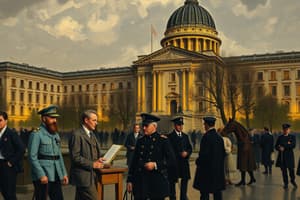Podcast
Questions and Answers
Which of these factors did NOT significantly contribute to the Nazi's rise in power during the Weimar Republic?
Which of these factors did NOT significantly contribute to the Nazi's rise in power during the Weimar Republic?
- Resentment towards the Treaty of Versailles
- Widespread fear of communism
- Economic hardship and hyperinflation
- Support from other political parties for Hitler (correct)
The Beer Hall Putsch in 1923 was a successful attempt by the Nazi Party to overthrow the Weimar Republic.
The Beer Hall Putsch in 1923 was a successful attempt by the Nazi Party to overthrow the Weimar Republic.
False (B)
Which of the following was NOT a direct consequence of the Treaty of Versailles on Germany?
Which of the following was NOT a direct consequence of the Treaty of Versailles on Germany?
- Significant territorial losses
- Mandatory disarmament
- Imposition of heavy reparations
- Establishment of a stable, long-lasting coalition government (correct)
What paramilitar organization did the Nazi Party use to intimidate political opponents and maintain order at rallies?
What paramilitar organization did the Nazi Party use to intimidate political opponents and maintain order at rallies?
The Dawes Plan and Young Plan completely solved Germany's reparations issues and stabilized its economy in the long term.
The Dawes Plan and Young Plan completely solved Germany's reparations issues and stabilized its economy in the long term.
The appointment of Hitler as _________ in January 1933 marked a crucial turning point, leading to the demise of the Weimar Republic.
The appointment of Hitler as _________ in January 1933 marked a crucial turning point, leading to the demise of the Weimar Republic.
What was the 'stab-in-the-back' myth (Dolchstosslegende), and whom did it blame for Germany’s defeat in WWI?
What was the 'stab-in-the-back' myth (Dolchstosslegende), and whom did it blame for Germany’s defeat in WWI?
Match the following events or factors with their MOST significant long-term consequence:
Match the following events or factors with their MOST significant long-term consequence:
Article 48 of the Weimar Constitution allowed the president to rule by _______ in times of emergency.
Article 48 of the Weimar Constitution allowed the president to rule by _______ in times of emergency.
Match the following events with their descriptions:
Match the following events with their descriptions:
Which of the following was NOT a short-term consequence of the Weimar Republic's political fragmentation?
Which of the following was NOT a short-term consequence of the Weimar Republic's political fragmentation?
One of the long-term consequences of the Weimar Republic was a weakened German democracy.
One of the long-term consequences of the Weimar Republic was a weakened German democracy.
Which factor was LEAST influential in the rise of the Nazi Party?
Which factor was LEAST influential in the rise of the Nazi Party?
The Weimar Republic successfully maintained political stability and avoided any major uprisings or attempted coups throughout its entire existence.
The Weimar Republic successfully maintained political stability and avoided any major uprisings or attempted coups throughout its entire existence.
What global conflict did Nazi expansionist policies lead to?
What global conflict did Nazi expansionist policies lead to?
Describe one long-term consequence of the hyperinflation crisis of 1923 on German society and politics.
Describe one long-term consequence of the hyperinflation crisis of 1923 on German society and politics.
The systematic persecution and murder of millions of Jews and other minorities by the Nazi regime is known as the ________.
The systematic persecution and murder of millions of Jews and other minorities by the Nazi regime is known as the ________.
During the Weimar Republic era, name the treaty that contributed to nationalist sentiment due to perceived unfair terms?
During the Weimar Republic era, name the treaty that contributed to nationalist sentiment due to perceived unfair terms?
The influx of former soldiers into _______ groups after WWI contributed to the political violence and instability of the Weimar Republic.
The influx of former soldiers into _______ groups after WWI contributed to the political violence and instability of the Weimar Republic.
Insanely Difficult: How did the proportional representation system within the Weimar Republic's Reichstag contribute to governmental instability, considering the broader socio-political context of the time?
Insanely Difficult: How did the proportional representation system within the Weimar Republic's Reichstag contribute to governmental instability, considering the broader socio-political context of the time?
Flashcards
Weimar Republic
Weimar Republic
German government from 1919 to 1933, after WWI.
"Stab-in-the-back" Myth
"Stab-in-the-back" Myth
Post-WWI idea blaming socialists and Jews for Germany's defeat.
Kapp Putsch
Kapp Putsch
Right-wing attempt to overthrow the Weimar government in 1920.
Article 48
Article 48
Signup and view all the flashcards
Hyperinflation (1923)
Hyperinflation (1923)
Signup and view all the flashcards
Dawes Plan (1924)
Dawes Plan (1924)
Signup and view all the flashcards
The Great Depression
The Great Depression
Signup and view all the flashcards
Nazi Party
Nazi Party
Signup and view all the flashcards
Spartacist Uprising
Spartacist Uprising
Signup and view all the flashcards
Young Plan (1929)
Young Plan (1929)
Signup and view all the flashcards
What was the SA?
What was the SA?
Signup and view all the flashcards
What was the Beer Hall Putsch?
What was the Beer Hall Putsch?
Signup and view all the flashcards
What was the Treaty of Versailles?
What was the Treaty of Versailles?
Signup and view all the flashcards
What was hyperinflation?
What was hyperinflation?
Signup and view all the flashcards
What was the Great Depression?
What was the Great Depression?
Signup and view all the flashcards
What did the Nazi rise to power mean short-term?
What did the Nazi rise to power mean short-term?
Signup and view all the flashcards
What did the Nazi rise to power mean long-term?
What did the Nazi rise to power mean long-term?
Signup and view all the flashcards
What was political fragmentation?
What was political fragmentation?
Signup and view all the flashcards
Weakening of democracy?
Weakening of democracy?
Signup and view all the flashcards
What was World War II?
What was World War II?
Signup and view all the flashcards
Study Notes
- The Weimar Republic was the German government from 1919 to 1933, established after World War I and replaced by Nazi Germany.
Topic 1: The Impact of World War I
- Germany's defeat in WWI led to the collapse of the monarchy and the establishment of the Weimar Republic.
- The Treaty of Versailles imposed significant territorial losses, disarmament, and reparations on Germany.
- The "stab-in-the-back" myth (Dolchstosslegende) emerged, blaming socialists, communists, and Jews for Germany's defeat.
- WWI created a sense of disillusionment, resentment, and political instability in Germany.
- Many soldiers returning from the war joined paramilitary groups (Freikorps) due to disillusionment.
Topic 2: Political Instability and Challenges
- The Weimar Republic faced numerous political challenges, including uprisings, assassinations, and frequent changes in government.
- The Spartacist Uprising (1919) was a communist revolt in Berlin, brutally suppressed by the Freikorps.
- The Kapp Putsch (1920) was a right-wing attempt to overthrow the government, which ultimately failed due to a general strike.
- Political assassinations, such as those of Matthias Erzberger and Walther Rathenau, demonstrated the political violence.
- Proportional representation in the Reichstag led to coalition governments, which were often unstable and short-lived.
- The Weimar Constitution, while democratic, had inherent weaknesses, such as Article 48, which allowed the president to rule by decree in emergencies.
Topic 3: Economic Crisis
- The Weimar Republic experienced severe economic problems, including hyperinflation in 1923.
- Hyperinflation was caused by the government printing excessive amounts of money to pay striking workers and reparations.
- The hyperinflation crisis wiped out savings, destabilized the economy, and led to social unrest.
- The Dawes Plan (1924) and Young Plan (1929) attempted to address the reparations issue by restructuring payments and providing loans.
- The Great Depression of 1929 had a devastating impact on Germany, leading to mass unemployment, poverty, and social unrest.
- Unemployment soared, creating hardship and driving people to extremist political parties.
Topic 4: Rise of the Nazi Party
- The Nazi Party, led by Adolf Hitler, exploited the political and economic crises to gain support.
- The Nazi Party promoted a nationalist, authoritarian, and anti-Semitic ideology.
- Hitler's charisma and propaganda skills attracted many who were disillusioned with the Weimar Republic.
- The SA (Sturmabteilung) was the Nazi Party's paramilitary wing, used to intimidate opponents and maintain order at rallies.
- The failed Beer Hall Putsch (1923) demonstrated the Nazi Party's early attempt to seize power.
- The Nazi Party gained increasing support in elections, becoming the largest party in the Reichstag by 1932.
- Key factors contributing to the Nazi's rise included economic hardship, fear of communism, resentment towards the Treaty of Versailles, and effective propaganda.
- In January 1933, Hitler was appointed Chancellor of Germany, marking the beginning of the end for the Weimar Republic.
Consequences of Key Topics
- The consequences can be divided into short-term (immediate) and long-term effects.
Short-Term Consequences (Weimar Republic Era)
- Political fragmentation: frequent changes in government and instability made effective governance difficult.
- Economic volatility: Hyperinflation and the Great Depression led to widespread economic hardship.
- Social unrest: Protests, strikes, and political violence were common occurrences.
- Rise of extremism: Support for extremist parties like the Nazis and Communists increased.
- Weakening of democracy: Loss of faith in the Weimar system made it vulnerable to authoritarianism.
Long-Term Consequences (Post-Weimar Era)
- Nazi Germany: The collapse of the Weimar Republic paved the way for the establishment of a totalitarian regime.
- World War II: Nazi expansionist policies led to a global conflict.
- The Holocaust: The Nazi regime systematically persecuted and murdered millions of Jews and other minorities.
- Division of Germany: After WWII, Germany was divided into East and West, reflecting the ideological divide of the Cold War.
- Legacy of trauma: The events of the Weimar and Nazi eras left a lasting impact on German society and culture.
- Re-evaluation of democracy: Post-war Germany embraced a more stable and resilient democratic system.
Specific Examples of Consequences
- Treaty of Versailles: Short-term: resentment and economic strain. Long-term: contributed to nationalist sentiment exploited by the Nazis.
- Hyperinflation: Short-term: Economic ruin for the middle class. Long-term: psychological impact and distrust in government.
- Great Depression: Short-term: mass unemployment. Long-term: increased support for extremist parties promising radical solutions.
- Nazi rise to power: Short-term: end of the Weimar Republic. Long-term: dictatorship, WWII, the Holocaust.
Conclusion
- The Weimar Republic’s failure was a result of a combination of factors including the legacy of WWI, political instability, economic crises, and the rise of extremist ideologies. The consequences were far-reaching and devastating, shaping the course of the 20th century.
Studying That Suits You
Use AI to generate personalized quizzes and flashcards to suit your learning preferences.
Description
Explore the Weimar Republic (1919-1933), established post-WWI, and its challenges. Learn about the impact of WWI, the Treaty of Versailles, and political instability. Discover the rise of extremist ideologies during this era.



